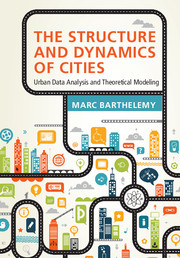Book contents
5 - Mobility patterns
Published online by Cambridge University Press: 10 November 2016
Summary
Mobility is obviously a crucial phenomenon in cities. In fact, it is probably one of the most important mechanisms that govern the structure and dynamics of cities. Indeed, individuals go to cities to buy, sell or exchange goods, to work, or to meet with other individuals and for this they need different transportation means. This is where technology enters the problem through the (average) velocity of transportation modes. This average velocity increased during the evolution of technology and modified the structure and organization of cities. For example, we see in Fig. 5.1 that the “horizon” of an individual depends strongly on her transportation mode. For a walker, the horizon is essentially isotropic and small, while the car allows for a wider exploration but one which is anisotropic and follows transportation infrastructures. This correlation between the spatial structure of the city and the available technology at the moment of its creation is clearly illustrated by Anas et al. (1998) for US cities. Many major cities, such as Denver or Oklahoma City, developed around rail terminals that triggered the formation of central business districts. In contrast, automobile-era cities that developed later, such as Dallas or Houston, have a spatial organization that is essentially determined by the highway system.
In terms of mobility, the city center is also the location that mimimizes the average distance to all other locations in the city. Very naturally, it is then the main attraction for businesses and residences, which leads to competition for space between individuals or firms, giving rise to the real-estate market. There is also a well-known relation between land-use and accessibility, as was discussed some time ago by Hansen (1959), and new, extensive datasets will certainly enable us in the future to characterize precisely the relation between these important factors.
It is of course very difficult to make an exhaustive review about all studies on mobility and we will focus in this chapter on several specific points. We will mostly describe the general features of mobility and will leave the discussion about multimodal aspects for Chapter 6.
Information
- Type
- Chapter
- Information
- The Structure and Dynamics of CitiesUrban Data Analysis and Theoretical Modeling, pp. 129 - 160Publisher: Cambridge University PressPrint publication year: 2016
Accessibility standard: Unknown
Why this information is here
This section outlines the accessibility features of this content - including support for screen readers, full keyboard navigation and high-contrast display options. This may not be relevant for you.Accessibility Information
- 1
- Cited by
